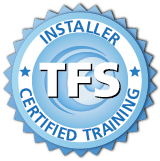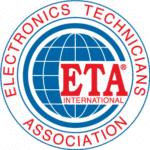
This fiber optic installation training course is designed for those who layout, install or maintain fiber optic cabling systems. It identifies you as a fiber optic installer able to demonstrate a practical knowledge of fiber optic theory, codes, standards and practices widely accepted in the fiber optics industry. In addition, this training incorporates two days of individual hands-on training validating fiber optic installer skills, including fiber terminations, cable preparations, fusion splicing, OTDR and optical loss testing. These skills are applicable to all the requirements to safely and competently install, maintain and test fiber optic cabling systems.
This fiber optic installation course is currently offered with a self-paced, online lecture and a hands-on workshop. This innovative approach to Fiber Optic Training and certification allows students to minimize expense, time and travel by learning at their own pace, on their own schedule (using online e-Learning to complete the lecture portion of the class.) Students may then complete the hands-on portion of the class at any of our scheduled sessions around the world (and can review the material within one year of registering for the course.) If online training is not ideal for your learning style, a more traditional instructor-led lecture or question and answer section is available upon request depending on the location and the size of the class.
TR-CFI is a BICSI CEC recognized course worth 19 BICSI CECs upon successful completion.
This course is classified as Level 1 Installer and it is followed by Level 2 Technician in the Professional Tracks. Our specialized Professional Tracks are two steps ahead of any other training programs available. These specialty programs build on the existing curriculum and then take it two extra steps. Paving your way to professional! FiberOptic.com will help you hone your skills to advance in your career.
Call 877-529-9114 or email training@fiberoptic.com for Professional Track scheduling.
Students must pass exam to be certified.
ETA FOI Certification

BICSI CEC recognized
TR-CFI is eligible for 19 BICSI Continuing Education Credits
NETA Recognized
TR-CFI is approved for 8 CTDs
Certified Fiber Installer training will provide the student with the necessary knowledge and skills to:
Lectures are self-paced and provide valuable information that will help you pass the certification exam. Online access is accessible for 1 year from the date you register. The lecture portion of this class is online and self-paced through our Learning Management System. Students receive a personal login to the platform providing access to lectures, study guides, practical exam, practice tests and technical exam. We recommend that the students complete the lecture before attending class. Lectures prepare students for the instructor led hands-on lab portion of the course. On the last day of the class each student will take a 75-question multiple choice test and if they pass, they will receive their certification in 2-3 weeks. Approximate time needed to complete lectures: 16 hours.
TL-01B – OSP Loose Tube Armored Cable Preparation
TL-01E – Buffer Tube Fan Out Kit (BTFO)
TL-02A – Fusion Splicing
TL-03A – Mechanical Splice Connector
TL-04A – Mechanical Splice
TL-05A – Pigtail Fusion Splice
TL-06A – Power Meter & Light Source Testing
TL-07A – Optical Time Domain Reflectometer (OTDR) Testing
TL20-A – Determining Power and Loss Budgets
Knowledge or experience in the areas of Fiber Optic Advantages and Applications, Cables, Connectors and Terminations, Enclosures and Panels, and Test Equipment would be helpful, but is not required.
Certified Fiber Installer is designed for new or experienced personnel seeking a deeper understanding of the installation of fiber optic cabling systems. This course is excellent for anyone involved in the construction, education, commercial, industrial, or utility markets and anyone who designs, installs, maintains, or tests fiber optic cabling systems.
Remember, if you have 5 or more students, we can bring our class to you at your own facility – saving you time and money!
Any of our courses can be customized to focus on your needs – like using specific equipment, or working in a particular situation.
FiberOptic.com and The Fiber School may cancel a course that lacks sufficient enrollment a week before it is scheduled to begin. When a course is cancelled, we make every effort to notify all registered students promptly. If The Fiber School cancels the course, students may elect to transfer to a future date.
Students who cancel within a week of the start of the course will be subject to a 50% cancellation fee and onsite or custom courses will be subject to a 100% cancellation fee.